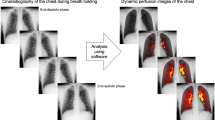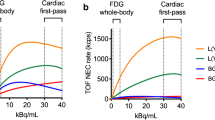Abstract
Thoracic positron emission tomographic (PET) scanning after injection of 6-[18F]fluorodopamine ([18F]-6F-DA) visualizes cardiac sympathetic innervation. We tested whether changes in curves relating myocardial [18F]-6F-DA-derived radioactivity with time (time-activity curves, TACs) can reflect changes in important aspects of cardiac sympatheticfunction. Thoracic PET scans were obtained after intravenous administration of [18F]-6F-DA or the perfusion imaging agent [13N]ammonia into normal volunteers. Ganglion blockade with trimethaphan (TRI) was used to decrease sympathoneural traffic, desipramine (DMI) to block neuronal uptake of catecholamines, and tyramine (TYR) to displace vesicular amines. After [18F]-6F-DA administration, myocardial concentrations of [18F]-6F-DA-derived radioactivity declined bi-exponentially from the peak value. TRI increased they-intercept (y o) value for the early phase (p=0.01), and DMI decreased they o for the late phase (p=0.01). The TRI effect did not result from increased arterial [18F]-6F-DA concentrations or from increased myocardial perfusion. TYR infusion, begun 90 min after [18F]-6F-DA administration, accelerated the decline of myocardial radioactivity by 2.6-fold (p=0.003). Alterations in post-ganglionic sympathoneural traffic, neuronal catecholamine uptake, and vesicular turnover of monoamines produce distinct changes in myocardial TACs after [18F]-6F-DA injection. [18F]-6F-DA PET scanning may therefore enable assessments of effects of stressors, drugs, and neurocardiological disorders on specific aspects of cardiac sympathoneural function.
Similar content being viewed by others
References
Goldstein DS, Chang PC, Eisenhofer Get al. Positron emission tomographic imaging of cardiac sympathetic innervation and function.Circulation 1990;81: 1606–1621.
Goldstein DS, Eisenhofer G, Dunn BBet al. Positron emission tomographic imaging of cardiac sympathetic innervation using 6-[18F]fluorodopamine: initial findings in humans.J Am Coll Cardiol 1993;22: 1961–1971.
Rutgers M, Tytgat GA, Verwijs-Janssen M, Buitenhuis C, Voute PA, Smets LA. Uptake of the neuron-blocking agent meta-iodobenzylguanidine and serotonin by human platelets and neuro-adrenergic tumour cells.Int J Cancer 1993;54: 290–295.
Ding YS, Fowler JS, Dewey SLet al. Comparison of high specific activity (−) and (+)-6-[18F]fluoronoradrenaline and 6-[18F]fluorodopamine in baboons: heart uptake, metabolism and the effect of desipramine.J Nucl Med 1993;34: 619–629.
Fowler JS, Ding YS, Volkow NDet al. PET studies of cocaine inhibition of myocardial noradrenaline uptake.Synapse 1994;16: 312–317.
Chiueh CC, Zukowska-Grojec Z, Kirk KL Kopin IJ. 6-Fluorocatecholamines as false adrenergic neurotransmitters.J Pharmacol Exp Ther 1983;225: 529–533.
Eisenhofer G, Hovevey-Sion D, Kopin IJet al. Neuronal uptake and metabolism of 2-and 6-fluorodopamine: false neurotransmitters for positron emission tomographic imaging of sympathetically innervated tissues.Pharmacol Exp Ther 1989;248: 419–427.
Grossman E, Rea RF, Hoffman A, Goldstein DS. Yohimbine increases sympathetic nerve activity and noradrenaline spillover in normal volunteers.Am J Physiol 1991;260: R142-R147.
Goldstein DS, Zimlichman R, Stull R, Keiser HR, Kopin IJ. Estimation of intrasynaptic noradrenaline concentrations in humans.Hypertension 1986;8: 471–475.
Szabo B, Schultheiss A. Desipramine inhibits sympathetic nerve activity in the rabbit.Naunyn-Schmiedeberg's Arch Pharmacol 1990;342: 469–476.
Eisenhofer G, Saigusa T, Esler MD, Cox HS, Angus JA, Dorward PK. Central sympathoinhibition and peripheral neuronal uptake blockade after desipramine in rabbits.Am J Physiol 1991;260: R824-R832.
Finberg J, Dibner-Dunlap M, Yuih SN, Thames MD. Effects of desipramine hydrochloride on peripheral sympathetic nerve activity.Am J Physiol 1990;258: R876-R882.
Esler MD, Wallin G, Dorward PKet al. Effects of desipramine on sympathetic nerve firing and noradrenaline spillover to plasma in humans.Am J Physiol 1991;260: R817-R823.
Eisenhofer G, Esler MD, Meredith ITet al. Sympathetic nervous function in the human heart as assessed by cardiac spillovers of dihydroxyphenylglycol and noradrenaline.Circulation 1992;85: 1775–1785.
Goldstein DS, Nurnberger J, Jr, Simmons S, Gershon ES, Polinsky R, Keiser HR. Effects of injected sympathomimetic amines on plasma catecholamines and circulatory variables in man.Life Sci 1983;32: 1057–1063.
Dunn BB, Channing MA, Adams HR, Goldstein DS, Kirk KL, Kiesewetter DO. A single column, rapid quality control procedure for 6-[18F]fluoro-L-dopa and 6-[18F]fluorodopamine PET imaging agents.Int J Rad Appl Instrum [B] 1991;18: 209–213.
Holmes C, Eisenhofer G, Goldstein DS. Improved assay for plasma dihydroxyphenylacetic acid and other catechols using high-performance liquid chromatography with electrochemical detection.J Chromatogr B Biomed Appl 1994;653: 131–138.
Goldstein DS, Brush JE, Jr, Eisenhofer G, Stull R, Esler M.In vivo measurement of neuronal uptake of noradrenaline in the human heart.Circulation 1988;78: 41–48.
Goldstein DS, Grossman E, Tamrat Met al. Positron emission imaging of cardiac sympathetic innervation and function using 18F-6-fluorodopamine: effects of chemical sympathectomy by 6-hydroxydopamine.J Hypertens 1991;9: 417–423.
Hovevey-Sion D, Eisenhofer G, Kopin IJet al. Metabolic fate of injected radiolabelled dopamine and 2-fluorodopamine in rats.Neuropharmacology 1990;29: 881–887.
Goldstein DS, Zimlichman R, Stull Ret al. Measurement of regional neuronal removal of noradrenaline in man.J Clin Invest 1985;76: 15–21.
Goldstein DS, Horwitz D, Keiser HR, Polinsky RJ, Kopin IJ. Plasma I-[3H]noradrenaline, d-[14C]noradrenaline, and d,I-[3H]isoproterenol kinetics in essential hypertension.J Clin Invest 1983;72: 1748–1758.
Chang PC, Szemeredi K, Grossman E, Kopin IJ, Goldstein DS. Fate of tritiated 6-fluorodopamine in rats: a false neurotransmitter for positron emission tomographic imaging of sympathetic innervation and function.J Pharmacol Exp Ther 1990;255: 809–817.
Saruta T, Suzuki H, Handa M, Igarashi Y, Kondo K, Senba S. Multiple factors contribute to the pathogenesis of hypertension in Cushing's syndrome.Circulation 1986;88: 388–394.
Garty M, Deka-Starosta A, Chang PCet al. Plasma levels of catechols during reflexive changes in sympathetic nerve activity.Neurochem Res 1989;14: 523–531.
Goldstein DS, Eisenhofer G, Stull R, Folio CJ, Keiser HR, Kopin IJ. Plasma dihydroxyphenylglycol and the intraneuronal disposition of noradrenaline in humans.J Clin Invest 1988;81: 213–220.
Deka-Starosta A, Garty M, Zukowska-Grojec Z, Keiser HR, Kopin IJ, Goldstein DS. Renal sympathetic nerve activity and noradrenaline release in rats.Am J Physiol 1989;257: R229-R236.
Eisenhofer G, Cox HS, Esler MD. Noradrenaline reuptake and plasma dihydroxyphenylglycol during sustained changes in sympathetic activity in rabbits.J Auton Nerv Sys 1991;32: 217–232.
Graefe KH, Bonisch H. The transport of amines across the axonal membranes of nonadrenergic and dopaminergic neurones. In: Trendelenburg U, Weiner N, eds.Catecholamines I. New York: Springer-Verlag, 1988; 193–245.
Iversen, L.L.The Uptake and Storage of Noradrenaline in Sympathetic Nerves. Cambridge: Cambridge University Press, 1967.
Mann GE, Yudilevich DL. Rapid transcapillary exchange and unidirectional neuronal uptake of noradrenaline in the perfused rabbit heart.J Physiol (Lond) 1984;348: 589–600.
Mertes PM, Carteaux JP, Jaboin Yet al. Estimation of myocardial interstitial noradrenaline release after brain death using cardiac microdialysis.Transplantation 1994;57: 371–377.
Kopin IJ, Breese GR, Krauss KR, Weise VK. Selective release of newly synthesized noradrenaline from the cat spleen during sympathetic nerve stimulation.J Pharmacol Exp Ther 1968;161: 271–278.
Musacchio JM, Weise VK, Kopin IJ. Mechanism of noradrenaline binding.Nature 1965;205: 606–607.
Musacchio JM, Kopin IJ, Weise VK. Subcellular distribution of some sympathomimetic amines and their β-hydroxylated derivatives in the rat heart.J Pharmacol Exp Ther 1965;148: 22–28.
Eisenhofer G, Goldstein DS, Ropchak TG, Nguyen HQ, Keiser HR, Kopin IJ. Source and physiological significance of plasma 3,4-dihydroxyphenylglycol and 3-methoxy-4-hydroxyphenylglycol.J Auton Nerv Syst 1988;24: 1–14.
Author information
Authors and Affiliations
Corresponding author
Rights and permissions
About this article
Cite this article
Goldstein, D.S., Holmes, C., Stuhlmuller, J.E. et al. 6-[18F]Fluorodopamine positron emission tomographic scanning in the assessment of cardiac sympathoneural function — studies in normal humans. Clinical Autonomic Research 7, 17–29 (1997). https://doi.org/10.1007/BF02267622
Received:
Accepted:
Issue Date:
DOI: https://doi.org/10.1007/BF02267622




